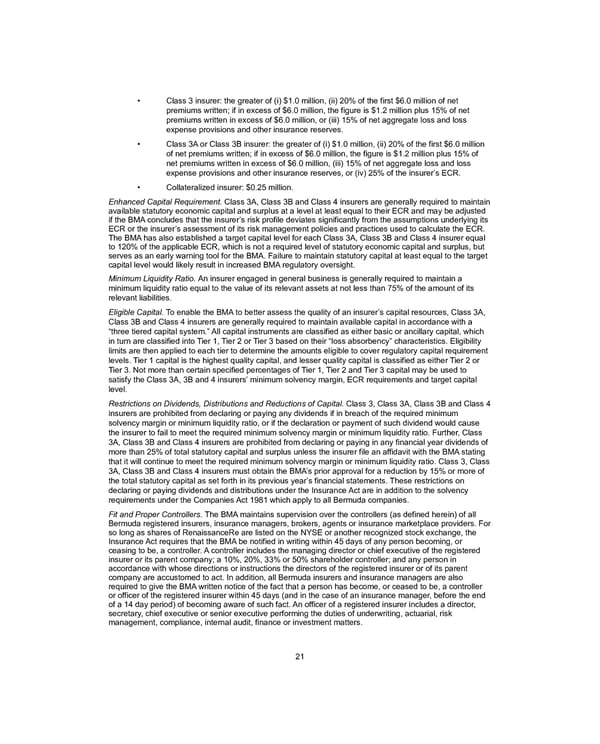• Class 3 insurer: the greater of (i) $1.0 million, (ii) 20% of the first $6.0 million of net premiums written; if in excess of $6.0 million, the figure is $1.2 million plus 15% of net premiums written in excess of $6.0 million, or (iii) 15% of net aggregate loss and loss expense provisions and other insurance reserves. • Class 3A or Class 3B insurer: the greater of (i) $1.0 million, (ii) 20% of the first $6.0 million of net premiums written; if in excess of $6.0 million, the figure is $1.2 million plus 15% of net premiums written in excess of $6.0 million, (iii) 15% of net aggregate loss and loss expense provisions and other insurance reserves, or (iv) 25% of the insurer’s ECR. • Collateralized insurer: $0.25 million. Enhanced Capital Requirement. Class 3A, Class 3B and Class 4 insurers are generally required to maintain available statutory economic capital and surplus at a level at least equal to their ECR and may be adjusted if the BMA concludes that the insurer’s risk profile deviates significantly from the assumptions underlying its ECR or the insurer’s assessment of its risk management policies and practices used to calculate the ECR. The BMA has also established a target capital level for each Class 3A, Class 3B and Class 4 insurer equal to 120% of the applicable ECR, which is not a required level of statutory economic capital and surplus, but serves as an early warning tool for the BMA. Failure to maintain statutory capital at least equal to the target capital level would likely result in increased BMA regulatory oversight. Minimum Liquidity Ratio. An insurer engaged in general business is generally required to maintain a minimum liquidity ratio equal to the value of its relevant assets at not less than 75% of the amount of its relevant liabilities. Eligible Capital. To enable the BMA to better assess the quality of an insurer’s capital resources, Class 3A, Class 3B and Class 4 insurers are generally required to maintain available capital in accordance with a “three tiered capital system.” All capital instruments are classified as either basic or ancillary capital, which in turn are classified into Tier 1, Tier 2 or Tier 3 based on their “loss absorbency” characteristics. Eligibility limits are then applied to each tier to determine the amounts eligible to cover regulatory capital requirement levels. Tier 1 capital is the highest quality capital, and lesser quality capital is classified as either Tier 2 or Tier 3. Not more than certain specified percentages of Tier 1, Tier 2 and Tier 3 capital may be used to satisfy the Class 3A, 3B and 4 insurers’ minimum solvency margin, ECR requirements and target capital level. Restrictions on Dividends, Distributions and Reductions of Capital. Class 3, Class 3A, Class 3B and Class 4 insurers are prohibited from declaring or paying any dividends if in breach of the required minimum solvency margin or minimum liquidity ratio, or if the declaration or payment of such dividend would cause the insurer to fail to meet the required minimum solvency margin or minimum liquidity ratio. Further, Class 3A, Class 3B and Class 4 insurers are prohibited from declaring or paying in any financial year dividends of more than 25% of total statutory capital and surplus unless the insurer file an affidavit with the BMA stating that it will continue to meet the required minimum solvency margin or minimum liquidity ratio. Class 3, Class 3A, Class 3B and Class 4 insurers must obtain the BMA’s prior approval for a reduction by 15% or more of the total statutory capital as set forth in its previous year’s financial statements. These restrictions on declaring or paying dividends and distributions under the Insurance Act are in addition to the solvency requirements under the Companies Act 1981 which apply to all Bermuda companies. Fit and Proper Controllers. The BMA maintains supervision over the controllers (as defined herein) of all Bermuda registered insurers, insurance managers, brokers, agents or insurance marketplace providers. For so long as shares of RenaissanceRe are listed on the NYSE or another recognized stock exchange, the Insurance Act requires that the BMA be notified in writing within 45 days of any person becoming, or ceasing to be, a controller. A controller includes the managing director or chief executive of the registered insurer or its parent company; a 10%, 20%, 33% or 50% shareholder controller; and any person in accordance with whose directions or instructions the directors of the registered insurer or of its parent company are accustomed to act. In addition, all Bermuda insurers and insurance managers are also required to give the BMA written notice of the fact that a person has become, or ceased to be, a controller or officer of the registered insurer within 45 days (and in the case of an insurance manager, before the end of a 14 day period) of becoming aware of such fact. An officer of a registered insurer includes a director, secretary, chief executive or senior executive performing the duties of underwriting, actuarial, risk management, compliance, internal audit, finance or investment matters. 21
 2021 Annual Report Page 36 Page 38
2021 Annual Report Page 36 Page 38